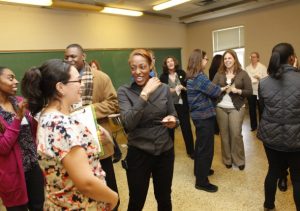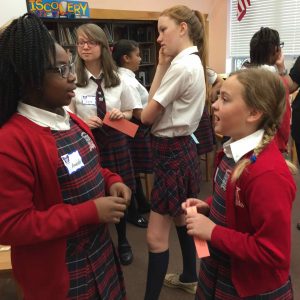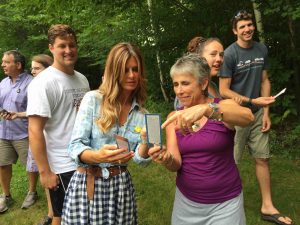Sep 07, 2017 Commonalities Mingle Activity for Rapport Building, Reflection, Positive Group Norms and Academic Review/Discussion
 Commonalities Mingle is an engaging activity for building rapport in groups of all kinds. It is also a useful method to reflect on academic or training material while at the same time learning about peers or colleagues and exploring common and differing perspectives on a topic. For those thinking of “Back-to-School,” it is a effective community builder for advisory groups and morning meetings. For team-building and networking programs it can facilitate the understanding of “who is in the room” and help participants make connections and start a dialogue about reflection topics.
Commonalities Mingle is an engaging activity for building rapport in groups of all kinds. It is also a useful method to reflect on academic or training material while at the same time learning about peers or colleagues and exploring common and differing perspectives on a topic. For those thinking of “Back-to-School,” it is a effective community builder for advisory groups and morning meetings. For team-building and networking programs it can facilitate the understanding of “who is in the room” and help participants make connections and start a dialogue about reflection topics.
Facilitation Suggestions
• Invite participants to mingle (move around the room or space) and then give a prompt to form groups by a category or topic. A good attention-getter is useful in this activity (see page 62 of the Tips & Tools book, or page 105 of Inspired Educator).
• Depending on the group’s makeup, age, or purpose for being together, ask participants to form groups with “get to know you” prompts such as: ›People born in the same season as you. ›People who like the same genre of movies as you. ›People who like similar sports/activities. ›For some humor, use one of my friend Anthony Curtis’ prompts: “People who used the same toothpaste as you this morning.”
•When trying to determine who is in the room, have them form groups by role or position at school or organization, or their reason for attending the training. • This activity moves quickly and doesn’t need to take more than about 10-15 minutes.
 Reflection Variation
Reflection Variation
The “report-out” or explanation shared by each group is the most important aspect. Usually, a representative from each group will share their theme or commonality with everyone. Through this process participants who haven’t yet found the “right” place are welcomed into groups. This discussion process enables everyone to find out more about who is in the room, make connections around shared goals or commonalities, and potentially gets everyone talking and reflecting about topics to frame an upcoming lesson.
It is always interesting to me how participants find each other, define these commonalities, and invite others into their groups. I like the reflective discussions that organically arise around these groupings. I often use this in combination with the entry tasks shared in my previous post or chapter five of Tips & Tools for the Art of Experiential Group Facilitation —asking participants to form groups of people whose buttons are similar in some way, or whose postcards or quotes have similar themes. As they work to form groups, participants engage in reflective dialogue around the interpretation of their postcard, quote, or object. An understanding of differing perspectives and common themes emerge.
Academic Variation
In an academic or training situation, have students group up by their perspectives on a character or event in history, their perspectives or reactions to a current event, their experiences with technology, or their predictions around an outcome to a problem being posed in class. 
Group Norms Variation
Recently in a faculty team-building session for a staff that was going through a change in leadership and structure I experimented with using this activity to explore group norms with positive outcomes. I started with the usual playful groupings and then after four or five of these, I started getting more reflective. I asked them to think about their upcoming school year and an important attitude or behavior that they believed would be important for staff members to embody to make the year a success. I said, “Group up with others who share your thoughts about this key behavior or attitude.” It ended up being one of the most valuable parts of our training day.
The staff of 80 ended up in 8 groups including one centered around communication, one around making positive assumptions around other’s intent, one about the language they use with and about each other and students. It turned into one of the most thoughtful group discussions on positive norms I’ve heard – and it happened in a casual, organic way as opposed to facilitator driven list making Q&A answer session. As each group shared out their reasoning for emphasizing their ideal behaviors, one teacher said “This is a great discussion. Let’s get some paper and write these down.” The list they made after each group shared their rationale became their focus for building positive group norms that school and were kept in the staff room for the rest of the year. 
Resources/References:
I learned the commonalities activity from Anthony Curtis of Adventureworks. He attributes his variation, which he calls “Incorporations,” to Weinstein and Goodman (Playfair).
This article is an excerpt from Tips & Tools for the Art of Experiential Group Facilitation by Jennifer Stanchfield. Stanchfield J(2014) Inspired Educator, Inspired Learner: Experiential, Brain-Based Activities to Engage, Motivate, Build Community and Create Lasting Lessons.



No Comments